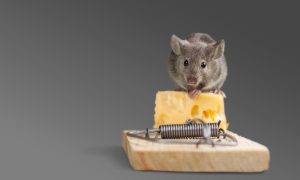USPTO Seeks a Better Mousetrap
- October 17, 2018
- Posted by: C.G. Moore, Ph.D.
- Category: Blog
 Build a better mousetrap, and the world will beat a path to your door. But if you’re particularly talented with Artificial Intelligence, then the United States Patent and Trademark Office will beat a path to your door.
Build a better mousetrap, and the world will beat a path to your door. But if you’re particularly talented with Artificial Intelligence, then the United States Patent and Trademark Office will beat a path to your door.
The USPTO issued a request for information on 13 September 2018 entitled Challenge to Improve Patent Search With Artificial Intelligence.[1] The Office’s stated goal is to identify and support the development of technology that can assist patent examiners with prior art searching during prosecution of patent applications.
As part of the patent examination process, a patent examiner must evaluate an applicant’s invention against “prior art” ― all information that has been made available to the public (in any form) before a given date, and that might be relevant to the application’s claims of novelty and non-obviousness.
Relevant prior art might consist of words, as in a scientific paper, but language and terms evolve over time. It might consist of chemical structures, such as chemical or biological polymers, but those can be described by a core structure and a long list of component parts that may (or may not) be added to the core in many thousands of unique combinations. Or it might be found a drawing that shows the relative positions of particular parts of a larger structure.
The relevance of these things to an applicant’s patent claims can all be evaluated by a human, but slowly, and subjectively. We are only beginning to see computer programs that can evaluate words in context, chemical and biological structures, and drawings, but they are no substitute for a human mind. Not yet.
The amount of publicly-available information is already enormous; some predict that the size of the digital universe will double every two years, and by 2025 will be 1 trillion gigabytes (163 zettabytes).[2] Currently available search tools (e.g., using Boolean search strings) can return thousands of potentially relevant results, but with the amount of available information growing so quickly, the signal (highly-relevant prior art) threatens to be overwhelmed by the noise of marginally-relevant material.
The increasingly vast and complex body of digitized human knowledge is particularly challenging for patent offices because of limited resources and limited time. Applicants for patent and patentees face these challenges too, from a slightly different perspective.
Fortunately, dramatically-improved search engines that rely on deep learning analytics to tackle the challenges of identifying relevant phrases, images, compounds, and concepts within Big Data-scale resources are being developed.
Just as the conversion of analog information sources greatly expanded the scope of easily-available prior art (think scientific journals and dissertations), the application of Artificial Intelligence solutions should soon let anyone frame complicated and nuanced questions against Big Data sets, and pull out meaningful results.
As such tools improve (e.g., by accurately identifying concepts―not just words―in a correct and relevant context), it is very possible that they will enable patent examiners to make much stronger (less subjective) rejections for “obviousness” or lack of “inventive step”.
The USPTO has already stated its interest. The time for applicants and patentees to prepare for this future is now.
[1] https://www.fbo.gov/utils/view?id=719670d083e8f92f9c11394b3895ef86
[2] International Data Corporation “Data Age 2025: The Evolution of Data to Life-Critical” (Apr. 2017), available at https://www.seagate.com/files/www-content/our-story/trends/files/Seagate-WP-DataAge2025-March-2017.pdf.
